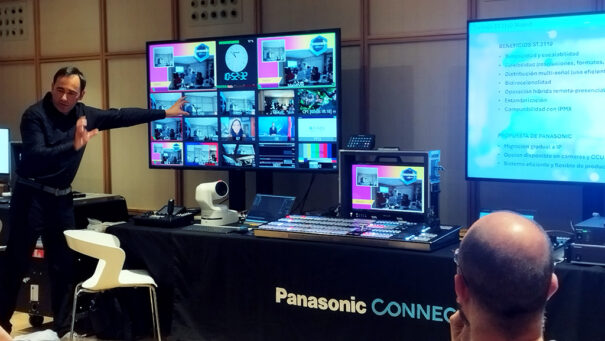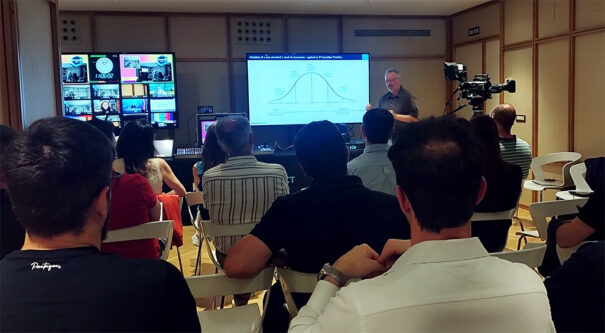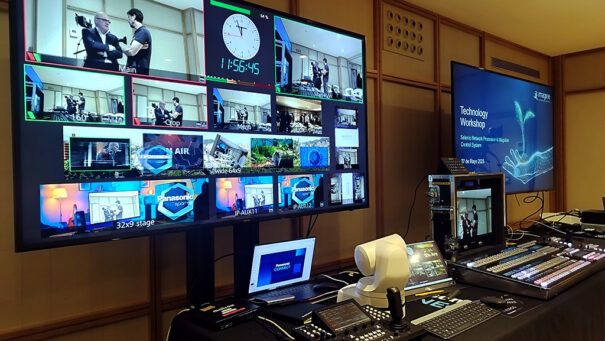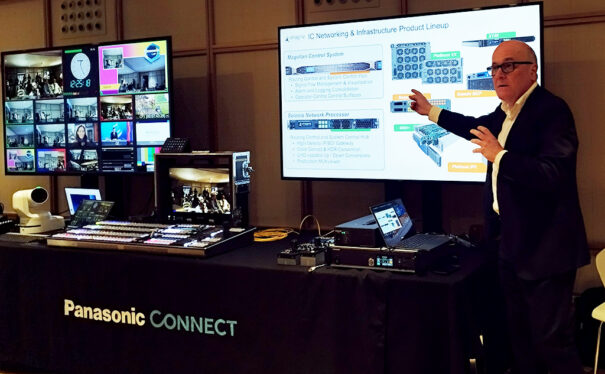Kairos (Panasonic) demonstrates the transition to IP in hybrid environments with ST 2110
El Hotel H10 Tribeca de Madrid ha acogido este martes un evento organizado por Panasonic, Imagine Communications y Broadcast Meditel en el que se ha podido descubrir en detalle los beneficios de la adopción de los flujos de trabajo SMPTE ST 2110, una transición imparable que ya está acompañada por soluciones robustas compatibles con las grandes exigencias de los contextos broadcast.
Durante los últimos años se ha hablado en profundidad sobre los beneficios de los entornos SMPTE ST 2110. Simplicidad, escalabilidad y flexibilidad son tres de los conceptos más intrínsecamente ligados a este universo, habilitando procesos con tiempos de configuración ampliamente optimizados en áreas como la distribución de señales, the bidireccionalidad de los procesos o las capacidades de operación remota.
Hace un lustro ya comenzamos a descubrir las primeras aplicaciones efectivas de este tipo de infraestructuras, pero ahora el panorama ha cambiado por completo. El IP ya no es una promesa para los entornos de producción, sino una realidad inamovible y a la que se dirige inevitablemente la industria de la radiodifusión. CTOs e ingenieros no pueden resistirse a esta transición, pero sí tienen la oportunidad de decidir de qué manera quieren acometerla.
Kairos: una ventana híbrida al mundo IP
Jaume Miró, responsable de proyectos a nivel europeo de Panasonic volcados en el universo IP, ha presentado las líneas maestras de Kairos, plataforma de arquitectura abierta especialmente dirigida a la producción de vídeo en directo. Entre ellas, destaca su capacidad para habilitar configuraciones locales, remotas o híbridas, o adaptarse a entornos multifabricante haciendo bandera de la interoperabilidad.
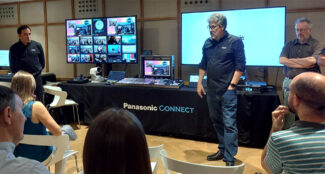 Al margen de estas claves, la solución destaca por reconocer la naturaleza híbrida de las infraestructuras broadcast contemporáneas. En palabras de Miró: “Nos encontramos en un momento de migración en el que no es tan fácil realizar una transición completa al IP. Hay que tener en cuenta señales, SDI, HDMI e incluso los gateways que facilitan el camino. No es todo o nada: somos conscientes de que se puede trabajar en IP y contar con entradas y salidas en banda bases preparadas para aportar todo tipo de soluciones”.
Al margen de estas claves, la solución destaca por reconocer la naturaleza híbrida de las infraestructuras broadcast contemporáneas. En palabras de Miró: “Nos encontramos en un momento de migración en el que no es tan fácil realizar una transición completa al IP. Hay que tener en cuenta señales, SDI, HDMI e incluso los gateways que facilitan el camino. No es todo o nada: somos conscientes de que se puede trabajar en IP y contar con entradas y salidas en banda bases preparadas para aportar todo tipo de soluciones”.
Los distintos servidores de Kairos pueden adaptarse según su modelo a configuraciones que prioricen entornos IP (AT-KC200 o AT-KC2000) o SDI (AT-KC200L1). En este marco, podrán interoperar con todo tipo de herramientas para ofrecer una visión clara del marco de producción, gestionar todas las señales independientemente de su procedencia o aprovechar todas las ventajas de Kairos a través de su interface Creator: panel de control virtual, creación de entornos de multipantalla o generación de títulos de grafismo.
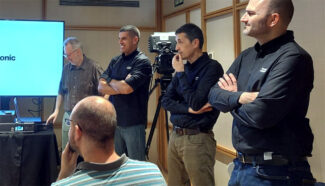 Asimismo, el sistema hace posibles procesos únicamente posibles en entornos IP. Entre ellos, Kairos muestra soluciones únicas en el mercado como Smart Routing, que permite transportar las señales hacia el mezclador bajo demanda para evitar la saturación de los anchos de banda (especialmente en entornos de trabajo UHD), o la creación de escenas complejas ocupando un mismo canal, como quedó demostrado con una demo de una composición de 20 señales diferentes con 20 correcciones de color únicas en un mismo canal.
Asimismo, el sistema hace posibles procesos únicamente posibles en entornos IP. Entre ellos, Kairos muestra soluciones únicas en el mercado como Smart Routing, que permite transportar las señales hacia el mezclador bajo demanda para evitar la saturación de los anchos de banda (especialmente en entornos de trabajo UHD), o la creación de escenas complejas ocupando un mismo canal, como quedó demostrado con una demo de una composición de 20 señales diferentes con 20 correcciones de color únicas en un mismo canal.
Otra herramienta clave es la interfaz de control de Kairos, que utiliza un “verdadero esquema cliente-servidor”, lo que permite que varios clientes puedan acceder al mismo servidor simultáneamente trabajando con distintas soluciones. De esta forma, un mismo core de Kairos podría gestionar un estudio principal con un panel de control, así como ser utilizado en paralelo con la interfaz táctil del sistema de Panasonic.
CCU-Less: la visión a futuro de Panasonic
El flujo de trabajo que los asistentes a la cita madrileña pudieron descubrir se componía, más allá del core Kairos funcionando sin redundancia, de la cámara de estudio AK-UCX100, con una conexión ST 2110 nativa en la cabeza de la cámara sin CCU; la cámara de estudio AK-PLV100, con una conexión ST 2110 nativa, la PTZ AW-UE160, y el procesador all in one Selenio SNP of Imagine Communications. Este despliegue, funcionando en tiempo real y configurado en apenas tres horas, sirvió para ejemplificar el potencial de la filosofía CCU-less (sin CCU) que ofrece Kairos.
Tal y como detalló Miró, el entorno de producción IP de Panasonic habilita que la gestión de las señales se pueda hacer con NMOS a través de un orquestador, pudiendo gestionar los retornos, si así se considera, desde el mezclador. “De esta manera se elimina tanto el coste como el espacio de las CCU, lo que permite hacer unidades móviles más pequeñas. Es una de las consecuencias del 2110”, explicó.
Christophe Almeras, business development manager de Panasonic especializado en el área de Kairos, también participó en el evento madrileño para compartir todas las novedades del sistema, como una inminente versión 2.0. que vendrá acompañada de una tarjeta HDMI y un nuevo diseño del área de trabajo. Al margen de poner en valor la solución y analizar cómo el advenimiento del IP ha traído consigo la hibridación de las tecnologías de producción broadcast y AV, se detuvo en las posibilidades de “reemplazar la CCU por un mero cable de fibra”: “Hoy en día, apenas hay procesos en la CCU: más que nada, se encarga de la distribución de señales en ambos sentidos. Esto es, precisamente, lo que sabe hacer el IP muy bien: enviar en un solo cable muchas señales de tipos diferentes”.
IPMX y el ecosistema de Imagine, clave para el presente de Kairos
Almeras también aprovechó su intervención para poner sobre la mesa los beneficios de IPMX, una suite de estándares abiertos y especificaciones para la gestión del contenido audiovisual a través de redes IP. “El 2110 funciona bien, pero los diferentes fabricantes lo han aplicado de manera diferente. ¿Cómo era el SDI hace 30 años? Igual. Como la interoperabilidad no es siempre perfecta, la idea es añadir obligaciones al 2110”, explicó el ingeniero francés, quien también subrayó que esta solución permite trabajar sin PTP de modo asíncrono y apuntó que su impulsora, la AIMS, se encuentra inmersa en el desarrollo de diferentes perfiles para facilitar su uso en diferentes contextos.
Las intervenciones finalizaron con una presentación de José María Álvarez, director de Qin Media, en la que detalló cómo varias soluciones clave de Imagine Communications se erigen como piezas clave en el rompecabezas que componen las infraestructuras broadcast IP. Concretamente, puso en valor la plataforma Selenio Network Processor, solución que ofrece control de enrutamiento IP/SDI integral, orquestación, monitorización y análisis en tiempo real, y el sistema de control Magellan, una solución interoperable que proporciona enrutamiento de señales SDI-IP de extremo a extremo y que continúa evolucionando para ofrecer, entre otras atractivas funciones, control entre sedes o compatibilidad con entornos en la nube.
Did you like this article?
Subscribe to our NEWSLETTER and you won't miss anything.



